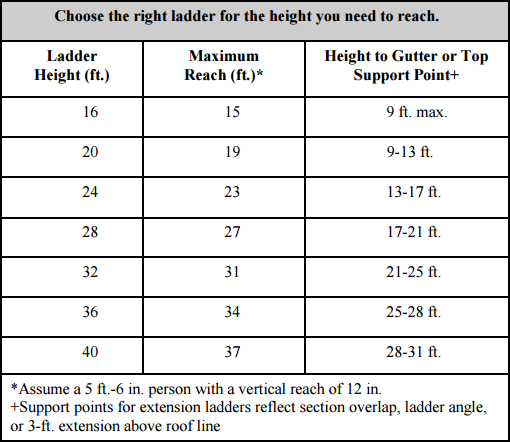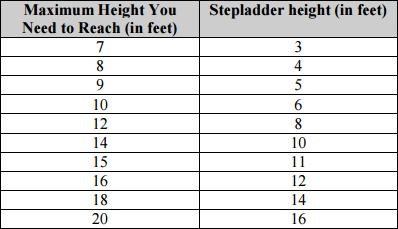|
UT Health Science Center GS5102 – Ladder Safety Policy | |
|
Version: 2 |
Effective Date: 11/21/2023 |
Objective
It is the responsibility of the University of Tennessee Health Science Center to ensure that the use of ladders are operated on the campus following OSHA, NFPA, and other federal, state and local regulations.
Scope
This policy applies to all faculty, staff, students and contractors who use or anticipate using a ladder. They must be able to recognize and avoid ladder hazards and be aware of safe practices in setting up, storing, moving and working with ladders, and comply with this policy.
This policy is intended to provide guidance to faculty, staff and students regarding use of ladders, which covers all types of ladders, including: step, extension and fixed ladders.
Roles
Campus Safety shall:
- Provide program oversight.
- Annually review the Ladder Safety Policy.
- Provide safety awareness training, as needed
- Assist supervisors in identifying hazardous conditions concerning ladders. Supervisors shall:
- Ensure all employees who use ladders follow this policy.
- Ensure inspection and maintenance practices for ladders are followed.
- Replace damaged equipment and remove from service.
- Ensure employees are trained to use equipment properly and in accordance with the manufacturer’s instructions.
UT Employees and students shall:
- Anticipate work hazards and ensure that safeguards are utilized.
- Conduct routine inspections to ensure that equipment is properly maintained.
- Report to their supervisor any equipment that needs to be repaired or replaced.
- Attend ladder safety training.
- Follow all safety guidelines for the use of equipment and according to manufacturer’s instructions.
Contractors and Subcontractors Shall:
- Provide appropriate personal protective equipment or other hazard control measures appropriate with work being conducted.
- Comply with UT HSC’s Ladder Safety policy and OSHA regulations.
- Ensure that a fully qualified OSHA program is in effect with the contractor/sub- contractor organization. The program is the responsibility of the Contractor and Subcontractors, individually. If a contractor sub-contracts to complete the work, then the Contractor is responsible for verification and compliance of the safety program of the subcontractor.
- Provide certifications when applicable, and requested.
- Ensure that his or her employees are appropriately trained and authorized.
- Ensure that a safety briefing has been completed prior to any work initiated, with all personnel involved including applicable University staff.
Abbreviations, Acronyms and Definitions
- CFR-Code of Federal Regulations
- OSHA-Occupational Safety and Health Administration
- TOSHA-Tennessee Occupational Safety and Health Administration
- Extension Ladder: A non-self-supporting portable ladder that is adjustable in length. It consists of two or more sections in guides or brackets that permit length adjustment. Length is designated by the sum of the lengths of each section, measured along the side rails.
- Fixed Ladder: A ladder that cannot be readily moved or carried because it is an integral part of a building or structure.
- Step Ladder: A self-supporting portable ladder, non-adjustable in length that has flat steps and a hinged back. Length is measured along the front edge of the side rail.
Procedure
- Pre-Use Inspections
- Ladders should be inspected prior to each use, and after any incident that could affect their safe se.
- Ladders with structural defects, such as: broken or missing rungs, cleats, or steps, etc. shall be marked defective or tagged with “Do Not Use” and withdrawn from service until repaired.
- OSHA rules for ALL ladders
- Maintain ladders free of oil, grease, and other slipping hazards.
- Do not load ladders beyond their maxim intended load nor beyond their manufacturer’s rated capacity.
- Use ladders only for their designated purpose.
- Use ladders only on stable and level surfaces unless secured to prevent accidental movement.
- Do not use ladders on slippery surfaces unless secured or provided with slip- resistant feet to prevent accidental movement. Do not use slip resistant feet as a substitute for exercising care when placing, lashing, or holding a ladder upon slippery surfaces.
- Keep areas clear around the top and bottom of ladders.
- Do not move, shift, or extend ladders while in use.
- Use ladders equipped with nonconductive side rails if the worker or the ladder could contact exposed energized electrical equipment.
- Face the ladder when moving up or down.
- Use at least one hand to grasp the ladder when climbing.
- Do not carry objects or loads that could cause loss of balance and falling.
- Secure ladders placed in areas, such as hallways and doorways, or where they can be displaced by workplace activities or traffic to prevent accidental movement.

- OSHA Fixed Ladder Safet.
24 feet or below:
There are no fall arrest requirements for fixed ladders under 24 feet. However, OSHA does support utilizing extra protection for fixed ladders under 24 feet to protect the safety of workers, and UTHSC shall encourage safety measures for these situations.
- Utilizing an affixed ladder (or others like it below 24 feet) shall have a fall restraint system that can clip on the rungs of the ladder to prevent an accidental fall either from any mishap while traversing the ladder.
- A recommended solution may be a ladder belt. Though designed for fire- fighting operations, a ladder belt can be used as a positioning device when on a ladder and as an emergency self-rescue device. It can also be used as an anchor tie-off and would prevent a fall when properly used to hook and unhook from each rung of the ladder.
NOTE: Under the Personal Fall Arrest systems, 29 CFR 1926.502(d), under subpart M, body belts (safety belts) are prohibited from use as part as a personal fall arrest system, and full body harnesses must be used. However, limited use of body belts (safety belts) can still be used as part of a positioning device system or fall restraint system.
29 CFR 1926.502(e) Positioning Device systems, OSHA defines a positioning device system as a body belt or body harness system rigged to allow a worker to be supported on an elevated vertical surface, such as a wall, and work with both hands free while leaning.
- Body belt or body harness systems are to be set up so that a worker can free fall no farther than 2 feet. 29 CFR 1926.502(e)(1).
- Body belts or harnesses must be secured to an anchorage capable of supporting at least twice the potential impact load of a worker’s fall or 3,000 pounds, whichever is greater. 29 CFR 1926.502(e)(2).
24 feet or Above:
- OSHA 1910.28(b)(9) requires General Industry employers to provide fall protection on fixed ladders more than 24′ above a lower level. This is also matched in Construction Standards OSHA (1926.1053(a)(18).
- Personal fall arrest systems, ladder safety systems, cage or well protections are required for these ladders 24 feet or higher.
- For new fixed ladders erected on or after November 19,2018, the employer must equip the ladder with a ladder safety or personal fall arrest system (1910.28(b)(9)(i)(B))
- For ladder repairs and replacements, when an employer replaces any portion of a fixed ladder, the replacement must be equipped with a ladder safety or personal fall arrest system (1910.28(b)(9)(i)(C))
- After November 18, 2036 all fixed ladders must be equipped with a ladder safety or personal fall arrest system (1910.28(b)(9)(i)(D))
4. OSHA Portable Ladder Safety
According to OSHA, falls from portable ladders are one of the leading causes of occupational injury. Below are general rules to follow when using portable ladders:
- Read and follow all manufacturer’s labels and markings on the ladder.
- Avoid electrical hazards. Look for overhead power lines before handling a ladder.
- Avoid using a metal ladder near power lines or exposed energized electrical equipment.
- Always inspect the ladder prior to using it. If the ladder is damaged, it must be removed from service and tagged until repaired or discarded.
- Always maintain a 3-point contact on the ladder when climbing. Keep your body near the middle of the step and always face the ladder when climbing.
- Only use ladders and accessories for their designated purposes.
- Ladders must be free of any slippery material on the rungs, steps or feet.
- Do not use a self-supporting ladder (i.e. step ladder) as a single ladder or in a partially closed position.
- Do not use the top step/rung of a ladder as a step/rung unless it was designated for that purpose.
- Use a ladder only on a stable and level surface, unless it has been secured (top or bottom) to prevent displacement.
- Do not place ladder on boxes, barrels or other unstable bases to obtain additional height.
- Do not move or shift a ladder while a person or equipment is on the ladder.
- An extension or straight ladder used to access an elevated surface must extend at least 3 feet above the point of support.
- Do not stand on the three top rungs of a straight, single, or extension ladder.
- The proper angle for setting up a ladder is to place its base a quarter of the working length of the ladder from the wall or other vertical surface.
- A ladder placed in any location where it can be displaced by other work activities must be secured to prevent displacement, or a barricade must be erected.
- Be sure that all locks on an extension ladder are properly engaged.
- Do not exceed the maximum load rating of a ladder
Choose a Stepladder that is no more than 4 ft. shorter than the height you want to reach.

Training and Information Requirements
- Under the provisions of the OSHA standard 1926.1060(a), employers must provide a training program for each employee using ladders. The program must enable each employee to recognize hazards related to ladders and to use proper procedures to minimize these hazards. For example, employers must ensure that each employee is trained by a competent person in the following areas, as applicable:
- The nature of fall hazards in the work area;
- The correct procedures for erecting, maintaining, and disassembling the fall protection systems to be used;
- he proper construction, use, placement, and care in handling of all ladders; and
- The maximum intended load-carrying capacities of ladders used. In addition, retraining must be provided for each employee, as necessary, so that the employee maintains the understanding and knowledge acquired through compliance with the standard.
Recordkeeping
An individual training record shall be maintained for each employee and kept for period of employment + 5 years.
The training instructor will document/certify the training and evaluation and will include in the documentation the name of the operator, the date of the training, the date of the evaluation, and the identity of the person(s) performing the training or evaluation.
Responsible Official & Additional Contacts
|
Subject Matter |
Office Name |
Telephone Number (xxx) xxx-xxxx |
Email/Web Address |
|
Policy Clarification and Interpretation |
Campus Safety and Emergency Management |
901-481-9801 | |
|
Policy Training |
Campus Safety and Emergency Management |
901-481-9801 | |
|
GS5102 – Ladder Safety Policy |
Attachments
- Attachment A: Ladder Safety Checklist
Related Policies/Guidance Documents
- OSHA: 29 CFR 1928
- OSHA: 29 CFR 1910.23
- UT System Safety Policy SA0100
- UT System Safety Policy SA0700






